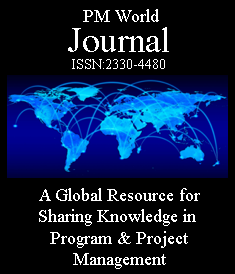A brief guide
Practical Project Risk Management
SERIES ARTICLE
By Martin Hopkinson
United Kingdom
Purposes
- Include a realistic assessment of the implications of risk in the project business case.
- Support the organisation’s governance of projects at major decision points.
- Implement a process that manages risk to both project delivery and project benefits.
Background
As a minimum, a project business case should address the project’s impact on both the burden of project delivery and the advantages to be realised by project benefits. In general, a project may be worth doing provided the value of its benefits exceed will exceed the cost of its delivery. If it is realistic to estimate both sides of this equation in terms of money, a benefits to cost ratio (BCR) can be forecast. For the business case to be reliable, the BCR must include realistic allowances for the implications of risk to both costs and benefits.
Effect of Optimism Bias on Project Cost and Benefits
Project costs tend to be underestimated rather than overestimated. Moreover, where project costs are underestimated, overspends can prove to be substantial, whereas underspends on projects with overestimated costs tend to be much smaller. Hence there is a bias towards optimism. Benefits tend to be similarly affected by optimism bias, but with the effect that the eventually realised value of benefits proves to be lower than originally estimated.
It should be noted that a combination of optimism bias in costs and benefits has a compound (multiplicative) effect. A simple illustration of this is:
- Take a Project with a forecast BCR of 4.0
- If the project cost is underestimated by a factor of two (and thus doubles) and the project benefits are overestimated by a factor of two (and thus halve), the resultant BCR is 1.0.
Risk and Bias often have a Greater Effect on Benefits than Costs
For a project to be worthwhile, its benefits must exceed its cost. Benefits should thus have a larger intrinsic value than cost. Moreover, benefits are usually realised further into the future than costs, making them more difficult to estimate and more susceptible to risk. Despite this, many projects fall into the trap of focussing on the management of cost risk, whilst neglecting risk to benefits. A key point is that project managers and project sponsors should use the development of the business case to ensure that this imbalance does not occur.
More…
To read entire article, click here
Editor’s note: This series of articles is by Martin Hopkinson, author of the books “The Project Risk Maturity Model” and “Net Present Value and Risk Modelling for Projects” and contributing author for Association for Project Management (APM) guides such as Directing Change and Sponsoring Change. These articles are based on a set of short risk management guides previously available on his company website, now retired. For an Introduction and context for this series, click here. Learn more about Martin Hopkinson in his author profile below.
How to cite this paper: Hopkinson, M. (2025). Business Case Risk: A brief guide, Practical Project Risk Management series, PM World Journal, Vol. XIV, Issue I, January. Available online at https://pmworldlibrary.net/wp-content/uploads/2025/01/pmwj148-Jan2025-Hopkinson-Business-Case-Risk-a-brief-guide.pdf
About the Author

Martin Hopkinson
United Kingdom
![]()
Martin Hopkinson, recently retired as the Director of Risk Management Capability Limited in the UK, and has 30 years’ experience as a project manager and project risk management consultant. His experience has been gained across a wide variety of industries and engineering disciplines and includes multibillion-pound projects and programmes. He was the lead author on Tools and Techniques for the Association for Project Management’s (APM) guide to risk management (The PRAM Guide) and led the group that produced the APM guide Prioritising Project Risks.
Martin’s first book, The Project Risk Maturity Model, concerns the risk management process. His contributions to Association for Project Management (APM) guides such as Directing Change and Sponsoring Change reflect his belief in the importance of project governance and business case development.
In his second book Net Present Value and Risk Modelling for Projects he brought these subjects together by showing how NPV and risk modelling techniques can be used to optimise projects and support project approval decisions. (To learn more about the book, click here.)
To view other works by Martin Hopkinson, visit his author showcase in the PM World Library at https://pmworldlibrary.net/authors/martin-hopkinson/









